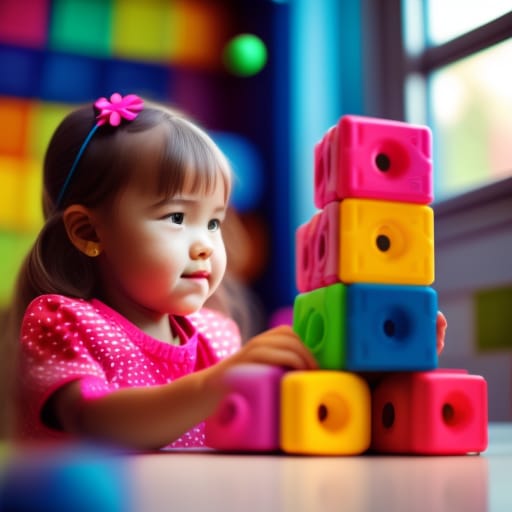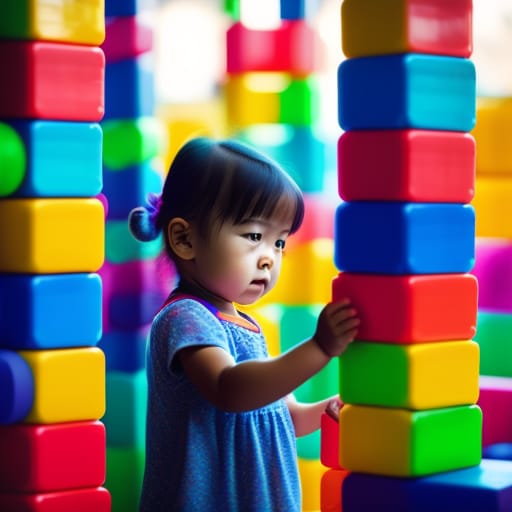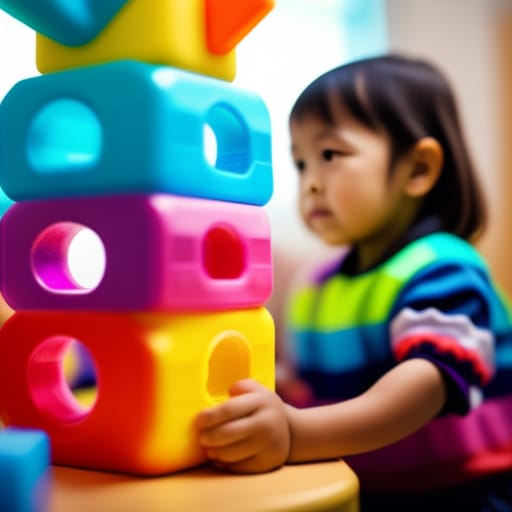Blocks are one of the most versatile and beneficial toys for preschool-aged children. As a parent, providing your little one with a variety of blocks to play and build with helps support their development in many crucial ways. This beginner’s guide will explore the world of preschool blocks and how they encourage growth and learning.

Why Blocks are Beneficial for Preschoolers
Blocks offer a wide range of developmental benefits for preschoolers ages 3-5 years old. Here are some of the key ways preschoolers can learn through block play:
- Cognitive Development – Blocks help promote cognitive abilities like problem-solving, spatial reasoning, and classification skills. As preschoolers imagine, build, and manipulate block structures, they strengthen important cognitive processes.
- Motor Skills – Handling and manipulating blocks develops fine motor control and hand-eye coordination. Building with blocks is great practice for small muscle development.
- Mathematics Skills – Blocks allow kids to explore foundational math concepts like sorting, matching, counting, shapes, patterns, measurement, and fractions in a hands-on way.
- Creativity and Self-Expression – There is no “right” way to build with blocks. This open-ended play encourages creativity, imagination, and self-expression without pressure.
- Collaboration – Building together with blocks promotes sharing, cooperation, communication, and other prosocial behaviors among preschoolers.
- Self-Confidence – Successfully planning and constructing block structures gives kids a great sense of pride and independence. This builds their confidence and self-esteem.
The American Academy of Pediatrics considers block play an essential activity for optimal child development. Handling and experimenting with blocks provides the mental stimulation and physical practice preschoolers need to grow.
Types of Blocks for Preschoolers
There are many varieties of preschooler blocks available to choose from. Consider providing your child with a diverse block collection to enrich their exploratory block play in different ways. Popular types of preschooler blocks include:
Wooden Blocks
- Classic, versatile blocks made from natural wood like maple, oak, or birch
- Smooth, sanded edges for safety
- Often come painted in bright colors
- Make a satisfying “clunk” sound when stacked due to their weight
- Can be stamped with letters, numbers, or shapes
- Develops fine motor skills and sensory exploration
- Sets are available in various sizes like jumbo blocks or mini blocks
Foam Blocks
- Lightweight blocks made from soft, colorful foam material
- Rounded edges make them very safe for younger toddlers
- Often featured in larger oversized shapes like prisms or pyramids
- Allow for easy grasping by little hands
- Great for squeezing, throwing, and safe roughhousing
- Develops gross motor skills and sensory stimulation
Plastic Blocks
- Affordable, durable blocks made from sturdy plastic
- Typically come in bright primary colors that can snap together
- Often have rounding edges for safety and holes in the center for grasping
- Very easy for small hands to manipulate and connect
- Great for building up tall towers and structures
- Develops fine motor skills and construction skills
Magnetic Blocks
- Blocks featuring magnets embedded inside that adhere together
- Allows for new block structures like arches, curves, and creative shapes
- Promotes spatial reasoning, geometry skills, and creativity
- Often have alphanumeric symbols or pictures on the sides for learning
- Develops construction skills and STEM thinking
Best Practices for Preschooler Block Play
To get the most learning value out of blocks, follow these simple guidelines:
- Make blocks easily accessible on low shelves so kids can access them independently
- Rotate through different types of blocks regularly to maintain interest
- Offer chunky blocks for easier grasping by little hands
- Provide small toy figures like animals or people to enhance imaginative play
- Allow plenty of open floor space for building structures and moving around
- Encourage collaborating on building projects with peers
- Let kids freely experiment and create their own designs without expectation
- Avoid overly structured block “lessons” which can limit creativity
- Join in the block play to model engineering talk like “Let’s add a pillar here for support”
- Introduce new block materials one at a time to focus exploration
- Take photos of block creations to develop planning and design skills
- Tidy up together to teach organization, sorting, and cleaning up
The secret is to let preschoolers take the lead with blocks and follow their interests. Resist the urge to control the play and instead participate as a facilitator who asks questions, makes observations, and supports their block discoveries.

Fun Block Activities for Preschoolers
Beyond open-ended building time, there are many engaging block activities you can set up to encourage learning through play:
Block Painting
- Dip wooden blocks in paint and make prints on paper to explore color mixing
Block Sorting
- Sort blocks by shape, size, color, or weight to develop classification skills
Block Patterns
- Create simple AB patterns by alternating block types to build sequencing abilities
Block Collages
- Glue blocks in creative designs to make 3D tactile artwork
Block Towers
- See how tall of a tower can be constructed before it topples over to learn about balance
Block Bridges
- Connect block towers together with a block “bridge” to teach engineering concepts
Block Cities
- Use wooden blocks, cars, and signs to build a mini city complete with buildings, streets, and parks to encourage imaginative play
Block Mazes
- Arrange blocks in winding paths and tunnels to crawl and climb through
Block Math Games
- Roll a die and count out the number of blocks to strengthen counting skills
Set aside time each week for engaging in block activities like these to build important developmental abilities in a fun way your preschooler will love.

Choosing the Best Preschooler Block Sets
When shopping for preschooler blocks, look for sets that offer:
- Solid wood or durable plastic construction
- Smooth, rounded edges for safety
- Vibrant colors to stimulate visual exploration
- A variety of shapes like rectangles, arches, and ramps to encourage building
- Handy storage containers or bags for easy clean-up
- Extras like alphabet symbols or activity guides for added play value
Here are some of the top-rated preschooler block sets available:
| Block Set | Description | Price |
|---|---|---|
| Hape Wooden Building Blocks | 70-piece maple wood blocks in rainbow colors with a storage pouch | $34 |
| Play22 Magnetic Building Blocks | 32 magnetic plastic blocks that stick together for creative building | $25 |
| Melissa & Doug 60 Piece Standard Unit Blocks | Hardwood blocks with alphanumeric imprinting for early math | $30 |
| Schylling Rubber ABC Blocks | Colorful rubber blocks with indented alphabet letters | $15 |
| Imagadora 51 Piece Giant Foam Blocks | Lightweight, oversized foam blocks in different shapes and colors | $27 |
Look for block sets that fit within your budget but still offer enough variety for open-ended construction and discovery. Avoid kits with too many small pieces that can get easily scattered and lost. Prioritize durable blocks in a range of shapes that will spark your preschooler’s imagination during play.
Frequently Asked Questions About Preschool Blocks
Here are answers to some common questions about block play:
How do blocks help preschool development?
Blocks support development across cognitive, motor, social-emotional, literacy, math, and communication domains. Preschoolers develop focus, spatial awareness, problem-solving, fine motor skills, sharing, cooperation, counting, shapes, colors, balance, organization, and more through imaginative block play.
What’s better – wooden or plastic blocks?
Each material offers different benefits. Wooden blocks have a timeless, high-quality appeal. Plastic blocks tend to be more affordable and offer bright colors and shapes like curves or magnetics. Aim for a mix of wood and plastic blocks to reap the unique advantages of each.
How can I teach STEM with blocks?
Encourage engineering thinking by discussing concepts like gravity, balance, and physics as kids build. Introduce new block pieces like ramps, pillars, and beams to explore structures. Ask open-ended questions about their block designs to develop critical thinking.
Should I give specific building ideas or leave the play open-ended?
Too much adult direction can limit imagination and frustration can arise if a child’s block creation doesn’t match the “plan”. Instead, give general suggestions like building upward or making shapes snap together then step back and let kids experiment.
Are blocks safe? What about choking hazards?
Look for blocks with rounded edges and too large to fit into the mouth whole to avoid choking risks. Monitor play to ensure proper use, especially when younger siblings are around. Avoid marbles, jacks, coins, and other small items that can pose safety issues during block play.
Providing an array of blocks tailored for your preschooler is an easy way to set them up for success. Block play builds the developmental foundation little ones need across motor, cognitive, social, literacy, STEM, and other skill domains while having creative, engaging fun!
So get ready to build, stack, and explore the wonderful world of preschool blocks! With the right blocks and a little imagination, your child will develop key skills while having a blast.